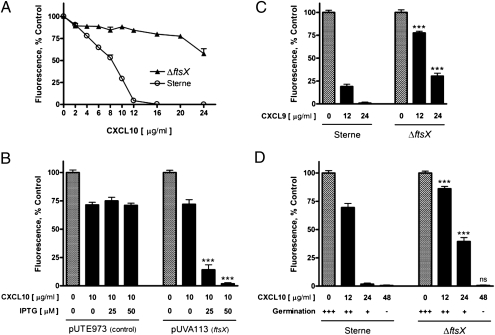Fig. 2.
Direct chemokine-mediated antimicrobial activity against B. anthracis ΔftsX bacilli and spores. (A) ΔftsX bacilli are resistant to human CXCL10; B. anthracis Sterne and ΔftsX bacilli were treated with increasing concentrations of CXCL10 for 6 h. Alamar blue reduction is expressed as a percentage of the strain-specific untreated control and data points represent mean values ± SEM; n = 4 independent experiments, curve comparison P < 0.001. (B) Complementation of ftsX restores CXCL10 susceptibility; ftsX-null bacilli were transformed with the IPTG-inducible plasmids pUTE973 (empty vector control) or pUVA113 (ftsX complementation vector) and treated with 10 μg/mL CXCL10 in the absence or presence of increasing IPTG concentrations. Data are expressed as a percentage of the appropriate untreated control (checkered bars) and represent mean values ± SEM; n = 3 independent experiments, ***P < 0.001 compared with similarly treated empty vector controls. (C) ΔftsX bacilli are resistant to murine CXCL9; Sterne and ΔftsX bacilli were treated with murine CXCL9 for 6 h. Alamar blue reduction is expressed as a percentage of the untreated control and represents mean values ± SEM; n = 3 independent experiments, ***P < 0.001 compared with murine CXCL9-treated Sterne bacilli. (D) ΔftsX spores are not resistant to CXCL10; Sterne and ΔftsX spores were treated with human CXCL10, and are shown together with the corresponding levels of relative spore germination ranging from >90% germination (+++) to no detectable germination (-) as determined visually. Alamar blue reduction, as an index of the resumption of metabolic activity, is expressed as percent control ± SEM; n = 3 independent experiments, ***P < 0.001, ns, not significant compared with CXCL10-treated Sterne spores.

